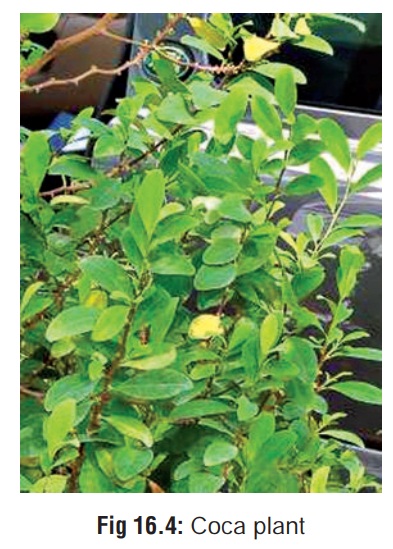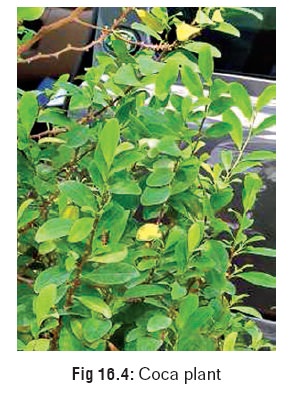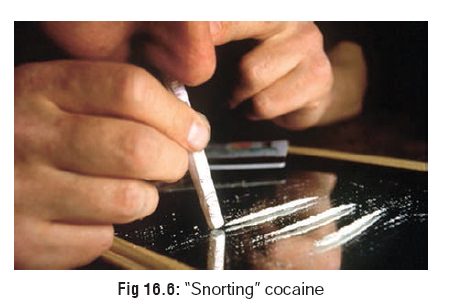Chapter: Modern Medical Toxicology: Neurotoxic Poisons: Stimulants
Cocaine - Stimulant Neurotoxic Poisons

Cocaine
Source
■■ Cocaine (“coke” or “snow”) is a natural alkaloid present in the leaves of the coca
plant (Fig 16.4), i.e. Erythroxyloncoca,** a shrub that grows
well in South America, Mexico,Indonesia, and West Indies.

■■ Chemically, cocaine is benzoylmethylecgonine, and belongs to the tropane family of natural alkaloids, other members of which include atropine and scopolamine.
■■ It occurs as colourless to white crystals, or white
crystal-line powder.
Mode of Intake
·
Cocaine is usually abused by either
chewing coca leaves, smoking coca paste, or “snorting” cocaine hydrochloride (Fig 16.5). The last mentioned is the
most popular form of cocaine intake, i.e. the drug is inhaled in powder form
through the nostrils (Fig 16.6).
Occasionally, cocaine hydrochloride is injected intravenously.


·
Today, a smokable form of cocaine (“crack” or “rock”) has virtually become a rage in the West. Pure alkaloidal
cocaine (“free-base” or “baseball”) can also be smoked.
Occasionally coca paste or cocaine sulfate (cocaine base, “pasta”, “bazooka”) is
smoked.
· Cocaine freebase is prepared from
cocaine hydrochloride by extracting the cocaine with an alkaline solution
(buffered ammonia) and adding a solvent such as ether or acetone. The mixture
separates into two layers, the top solvent layer containing the dissolved
cocaine. The solvent is then evaporated leaving almost pure cocaine crystals.
o
“Free-base” is a
colourless, odourless, transparent, crystalline substance that makes a popping
or cracking sound when heated (hence the term “crack”).
o Both free-base and crack are more stable to pyrolysis than the hydrochloride salt, and therefore can be smoked either using a “coke pipe” or mixed into a cigarette (“joint”).
o
A solution of cocaine hydrochloride can also be heated in a
pan with baking soda added until a solid “rock”
is formed, pieces of which can be smoked directly.![]()
· Street cocaine is often impure. The
content of pure cocaine ranges from 10 to 50 percent (most commonly 15 to 20
percent). Cocaine which is available on the street is often adulterated with
one or more of the following compounds: talc, lactose, sucrose, glucose,
mannitol, inositol, caffeine, procaine, phencyclidine, lignocaine, strychnine,
ampheta-mine, or heroin (“speed ball”).
Uses
· Topical anaesthetic (4 to 10%
solution) for intranasal and bronchoscopic procedures.
· Ophthalmologic anaesthesia.
· Relief of severe (oncologic) pain:
Cocaine is one compo-nent of Brompton’s cocktail, (the others being morphine,
chlorpromazine, and alcohol), which is popular in Europe for the control of
intractable pain associated with some forms of cancer.
·
Cocaine is one of the components of TAC (the others being
tetracaine and adrenaline) which is sometimes used as a topical anaesthetic in
children with scalp and facial lacera-tions.
Mode of Action
CNS:
·
Cocaine is the most powerful naturally derived CNS stimulant
known to man. Stimulation of the brain occurs in a rostral-to-caudal fashion.
The cortex is stimulated first resulting in excitement, restlessness, and
increased motor activity. Subsequent stimulation of lower motor centres
produces tonic-clonic convulsions. The medulla is at first stimulated resulting
in an initial increased respiratory rate, followed by depression with resultant
respiratory failure.
·
The CNS stimulant effects of cocaine are medi-ated through
inhibition of dopamine reuptake in the nucleus accumbens. The dopamine-reuptake
trans-porter controls the levels of dopamine in the synapse by rapidly carrying
the neurotransmitter back into nerve terminals after its release. Cocaine,
which binds strongly to the dopamine-reuptake transporter, is a classic blocker
of such reuptake after normal neuronal activity. Because of this blocking effect,
dopamine remains at high concentrations in the synapse and continues to affect
adjacent neurons producing the characteristic cocaine “high”.
·
Cocaine also increases the concentrations of the excitatory
amino acids, aspartate and glutamate in the nucleus accumbens. These excitatory
amino acids increase the extracellular concentrations of dopamine. Excitatory
amino acid antagonists attenuate the effects of cocaine induced convulsions and
death. Dopamine2 (D 2) receptor agonists accentuate
cocaine craving, while dopmanie1 (D1) agonists diminish
such craving.
·
![]() Cocaine also inhibits reuptake of noradrenaline and
serotonin. Increase in the concentrations of the former plays an important role
in the toxic effects of cocaine.
Cocaine also inhibits reuptake of noradrenaline and
serotonin. Increase in the concentrations of the former plays an important role
in the toxic effects of cocaine.
Peripheral nerves:
Through direct blockade of fast
sodium channels, cocaine stabilises the axonal membrane, producing a local
anaesthetic effect. Cocaine is the only local anaes-thetic that interferes with
the uptake of neurotransmitter by the nerve terminals and simultaneously
functions as vasoconstrictor.
CVS:
Initial effect of cocaine on the CVS
is bradycardia, secondary to stimulation of vagal nuclei. However, the
bradycardia is too transient to be clinically evident, and tachycardia becomes
the prominent effect resulting from central sympathetic stimula- tion. The
cardiostimulatory effect of cocaine is due in large part to sensitisation
to adrenaline and noradrenaline, preventing neuronal reuptake of these
catecholamines, as well as due to increased release of noradrenaline from
adrenergic nerve terminals. The increased concentrations and persistence of
catecho- lamines near the receptors of the effecter organ lead to exaggerated
sympathetic effects.
The
sympathomimetic effects of cocaine increase myocardial oxygen demand and the
alpha-adrenergic mediated coronary vasoconstriction limits coronary artery
blood flow.
Cocaine
inhibits endogenous fibrinolysis, increases thrombogenicity, and enhances
platelet aggregation.
Toxicokinetics
Absorption—
·
Ingestion
and insufflation: Cocaine is well-absorbed from oral, nasal, and pulmonary
routes. Onset of action on insufflation is within 1 to 3 minutes, and peak
effects are seen in 20 to 30 minutes.
·
Intravenous
injection: Onset of action is within seconds, and peak action occurs
in 3 to 5 minutes.
·
Inhalation:
Smoking produces effects as rapidly as IV injection.
Metabolism—
·
Cocaine is metabolised by liver
esterases and plasma cholinesterase to ecgonine methylester (EME), one of the
major metabolites, while non-enzymatic hydrolysis results in the formation of
the other major metabolite, benzoylecgonine (BE). Minor metabolites include
norcocaine ecgonine, ecgonidine, norecgonidine methyl ester, norecgonine methyl
ester, and m-hydroxybenzo-
ylecgonine.
·
Patients with lower plasma
cholinesterase levels may be predisposed to more severe cocaine toxicity. Since
children have lower plasma cholinesterase levels, they may be affected by
smaller amounts of cocaine. In addition, the metabolic half-life of cocaine may
be increased by lower plasma cholinesterase concentra- tions.
Excretion—
·
Excretion is mainly through urine.
Due to the long elimination half-life of BE, assays for its detection in urine
may be successful up to 2 to 3 days following cocaine use. In rare cases, it
has been detected even after 3 weeks.
Related Topics